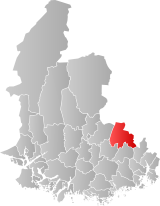| Hægeland Municipality Hægeland herred | |
|---|---|
| Former municipality | |
 View of the local church in Hægeland View of the local church in Hægeland | |
 Vest-Agder within Norway Vest-Agder within Norway | |
 Hægeland within Vest-Agder Hægeland within Vest-Agder | |
| Coordinates: 58°23′00″N 07°44′28″E / 58.38333°N 7.74111°E / 58.38333; 7.74111 | |
| Country | Norway |
| County | Vest-Agder |
| District | Sørlandet |
| Established | 1 July 1896 |
| • Preceded by | Øvrebø og Hægeland Municipality |
| Disestablished | 1 Jan 1964 |
| • Succeeded by | Vennesla Municipality |
| Administrative centre | Hægelandskrossen |
| Area | |
| • Total | 194 km (75 sq mi) |
| Population | |
| • Total | 849 |
| • Density | 4.4/km (11/sq mi) |
| Demonym | Hægdøl |
| Time zone | UTC+01:00 (CET) |
| • Summer (DST) | UTC+02:00 (CEST) |
| ISO 3166 code | NO-1015 |
| Data from Statistics Norway | |
Hægeland is a former municipality in Vest-Agder county, Norway. The 194-square-kilometre (75 sq mi) municipality existed from 1896 until its dissolution in 1964. The municipality was located in the northwestern part of the present-day municipality of Vennesla. The administrative centre was the village of Hægelandskrossen where Hægeland Church is located.
History
The municipality of Hægeland was established on 1 July 1896 when the old municipality of Øvrebø og Hægeland was divided into the separate municipalities of Hægeland (population: 843) and Øvrebø (population: 888). During the 1960s, there were many municipal mergers across Norway due to the work of the Schei Committee. On 1 January 1964, the municipality of Hægeland (population: 849) was dissolved and merged with the neighboring municipalities of Vennesla (population: 7,321), and most of Øvrebø (population: 925) to form a new Vennesla municipality. (Vennesla was previously part of the old municipality of Øvrebø og Hægeland until 1865).
Name
The municipality (originally the parish) is named after the old Hægeland farm (Old Norse: Helgaland) since the first Hægeland Church was built there. The first element comes from the word heilagr which means "holy", likely since this area was important to ancient Norse pagan worship. The last element is land which means "land" or "district".
Government
While it existed, this municipality was responsible for primary education (through 10th grade), outpatient health services, senior citizen services, unemployment, social services, zoning, economic development, and municipal roads. During its existence, this municipality was governed by a municipal council of directly elected representatives. The mayor was indirectly elected by a vote of the municipal council.
Municipal council
The municipal council (Herredsstyre) of Hægeland was made up of representatives that were elected to four year terms. The tables below show the historical composition of the council by political party.
| Party name (in Norwegian) | Number of representatives | |
|---|---|---|
| Labour Party (Arbeiderpartiet) | 3 | |
| Joint List(s) of Non-Socialist Parties (Borgerlige Felleslister) | 10 | |
| Total number of members: | 13 | |
| Party name (in Norwegian) | Number of representatives | |
|---|---|---|
| Labour Party (Arbeiderpartiet) | 4 | |
| Joint List(s) of Non-Socialist Parties (Borgerlige Felleslister) | 8 | |
| Local List(s) (Lokale lister) | 1 | |
| Total number of members: | 13 | |
| Party name (in Norwegian) | Number of representatives | |
|---|---|---|
| Labour Party (Arbeiderpartiet) | 4 | |
| Joint List(s) of Non-Socialist Parties (Borgerlige Felleslister) | 8 | |
| Total number of members: | 12 | |
| Party name (in Norwegian) | Number of representatives | |
|---|---|---|
| Labour Party (Arbeiderpartiet) | 4 | |
| Joint List(s) of Non-Socialist Parties (Borgerlige Felleslister) | 8 | |
| Total number of members: | 12 | |
| Party name (in Norwegian) | Number of representatives | |
|---|---|---|
| Labour Party (Arbeiderpartiet) | 4 | |
| Local List(s) (Lokale lister) | 8 | |
| Total number of members: | 12 | |
| Party name (in Norwegian) | Number of representatives | |
|---|---|---|
| Labour Party (Arbeiderpartiet) | 3 | |
| Farmers' Party (Bondepartiet) | 5 | |
| Liberal Party (Venstre) | 4 | |
| Total number of members: | 12 | |
| Note: Due to the German occupation of Norway during World War II, no elections were held for new municipal councils until after the war ended in 1945. | ||
See also
References
- "Navn på steder og personer: Innbyggjarnamn" (in Norwegian). Språkrådet.
- Bolstad, Erik; Thorsnæs, Geir, eds. (26 January 2023). "Kommunenummer". Store norske leksikon (in Norwegian). Kunnskapsforlaget.
- ^ Store norske leksikon. "Hægeland" (in Norwegian). Retrieved 16 January 2017.
- Jukvam, Dag (1999). Historisk oversikt over endringer i kommune- og fylkesinndelingen (PDF) (in Norwegian). Statistisk sentralbyrå. ISBN 9788253746845.
- Rygh, Oluf (1912). Norske gaardnavne: Lister og Mandals amt (in Norwegian) (9 ed.). Kristiania, Norge: W. C. Fabritius & sønners bogtrikkeri. p. 41 and 34.
- Hansen, Tore; Vabo, Signy Irene, eds. (20 September 2022). "kommunestyre". Store norske leksikon (in Norwegian). Kunnskapsforlaget. Retrieved 3 August 2023.
- "Kommunevalgene og Ordførervalgene 1959" (PDF) (in Norwegian). Oslo: Statistisk sentralbyrå. 1960. Retrieved 21 November 2020.
- "Kommunevalgene og Ordførervalgene 1955" (PDF) (in Norwegian). Oslo: Statistisk sentralbyrå. 1957. Retrieved 21 November 2020.
- "Kommunevalgene og Ordførervalgene 1951" (PDF) (in Norwegian). Oslo: Statistisk sentralbyrå. 1952. Retrieved 21 November 2020.
- "Kommunevalgene og Ordførervalgene 1947" (PDF) (in Norwegian). Oslo: Statistisk sentralbyrå. 1948. Retrieved 21 November 2020.
- "Kommunevalgene og Ordførervalgene 1945" (PDF) (in Norwegian). Oslo: Statistisk sentralbyrå. 1947. Retrieved 21 November 2020.
- "Kommunevalgene og Ordførervalgene 1937" (PDF) (in Norwegian). Oslo: Statistisk sentralbyrå. 1938. Retrieved 21 November 2020.
| Agder county, Norway | |||||||||||
|---|---|---|---|---|---|---|---|---|---|---|---|
| |||||||||||
 | Towns and cities |
| |||||||||
| Municipalities |
| ||||||||||
| |||||||||||
Categories: